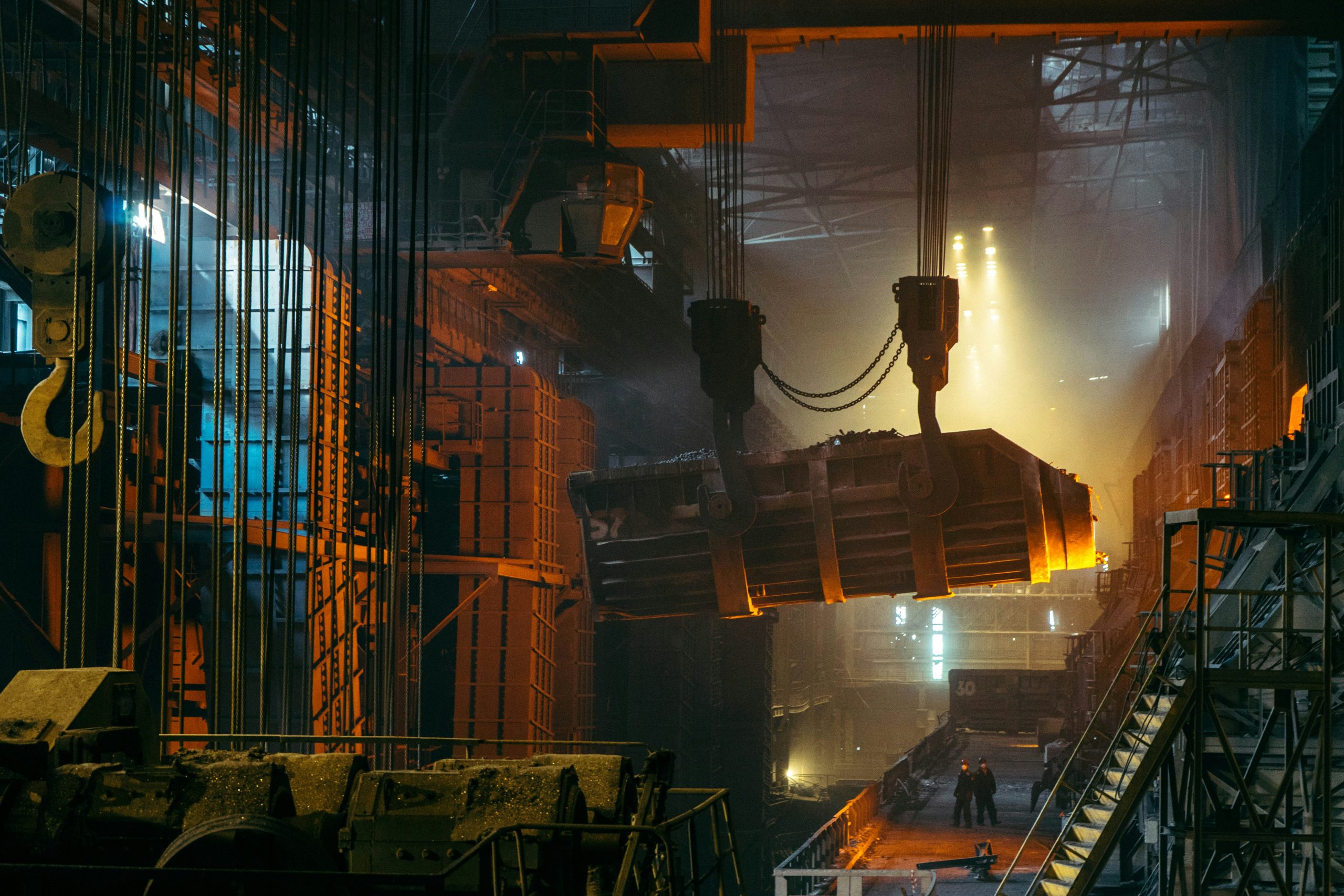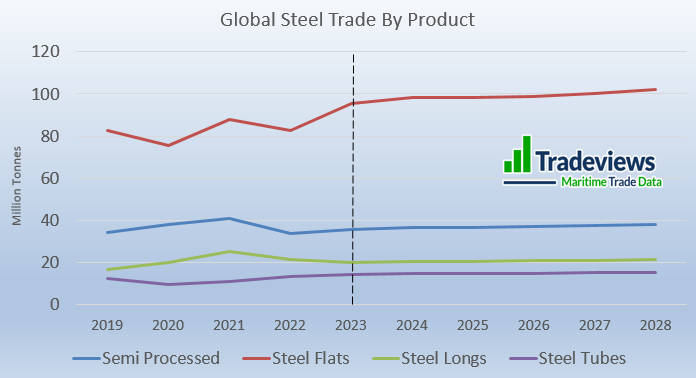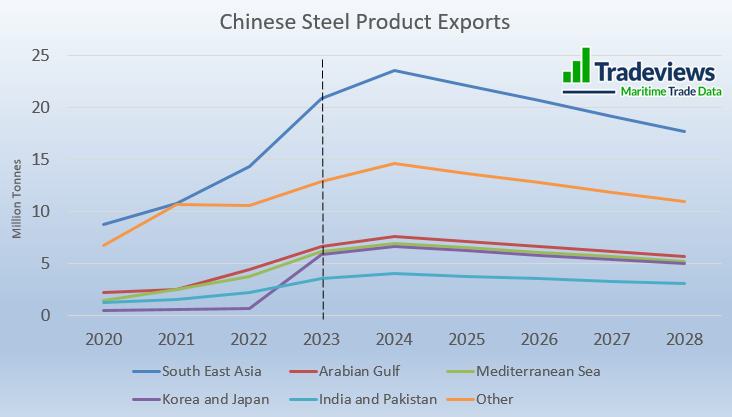Steel export trade can often be in the news for the wrong reasons. Anti-dumping legislation, particularly in the US, gives the impression of a protectionist landscape. As we mentioned in a previous article on US steel imports, China is a small part of the overall picture that often gets a lot of the attention.

Steel export trade has a wide dispersion, more than any other bulk or break-bulk commodity. Typically, bulk cargo is exported by a resource rich country to a resource poor country. As steel is important to a national security, most countries produce a decent quantity. Therefore, we find that steel trade is a very complex and contains a wide web of smaller trades. There are few large trades that dominate. As countries go through development cycles steel trade can swing violently between countries as their economic position changes. China and India are good examples of this recently.
As we will discover when we look at the different types of steel, there are a wide variety of uses. The largest group is manufacturing where it’s a key component for consumer products like cars and domestic appliances. Construction is the second largest category, and this is very closely linked to a country’s infrastructure development.
Why is steel traded between countries?
Even if a country has a surplus of steel production capacity, it will still have a portion of imported steel. This is because there are many steel grades and types of steel and not every country can produce everything. Therefore, steel behaves unlike any other bulk commodity.
What are the different types of steel products?
There are three different groups of steel classified in shipping:
- Semi processes steel
- Steel products
- Scrap steel (recycled steel)

Semi processed steel is the first product out of the smelting process. It comes in 3 forms: slab, billet and bloom. These can then be formed into a steel product on site or shipped to another facility that specialises in particular steel products.
Steel products normally fall into three categories of ‘longs’, ‘flats’ and ‘pipes’. Longs are generally for construction, particularly girders, using blooms as the main input material. Flats are mainly used in manufacturing items like cars, ships or washing machines. Pipes and tubes are used for urban infrastructure, oil drilling and transportation.
Scrap steel (probably more politically correct to say recycled steel) is one of the industry’s most important raw materials. It comes from demolished structures and end of life vehicles and machinery as well as from the yield losses in the steelmaking process. It is estimated that around 670 million tonnes of scrap were recycled in 2017. Of this, approximately 570 million tonnes were used by the global steel industry as an input ingredient.
How is steel export trade shipped – bulk or containers?
The steel products outlined above are mainly shipped in bulkers, either Supramax or Handy-size vessels. Tradeviews proprietary data estimates that in 2024 a total of 367 million tonnes will be shipped with 254 million tonnes going in bulkers. Thus approximately 70% will be shipped in bulkers and the remaining 30% in containers. The ratio of bulkers vs containers is different for every country. The balance depends on multiple factors including port infrastructure, volumes, comparative transportation costs and stockyard logistics.
Are steel products turn into something else?
All steel products end up being transformed again into a consumer product that will most likely be transported in containers. The other use of steel products is for large engineering projects which, if not built at site, can be moved using a special heavy lift vessel.
Who are the top 10 steel export trade countries?
Below is a table showing the quantity of steel exported in 2023. It includes all the main categories mentioned in this report. You can purchase more detailed data if you follow this link.
| Top 10 Steel Exports in 2023 | ||
| Position | Country | Million Tonnes |
| 1 | China | 56.0 |
| 2 | Japan | 28.3 |
| 3 | Russian Federation | 20.2 |
| 4 | South Korea | 17.1 |
| 5 | Brazil | 12.9 |
| 6 | USA | 10.2 |
| 7 | United Kingdom | 6.3 |
| 8 | Netherlands | 5.9 |
| 9 | Turkey | 5.7 |
| 10 | Oman | 5.6 |
Who are top 10 steel importing countries?
Likewise, here is a similar dataset for the steel importers.
| Top Ten Steel Imports in 2023 | ||
| Pos. | Country | Million Tonnes |
| 1 | Turkey | 28.8 |
| 2 | USA | 23.2 |
| 3 | Viet Nam | 14.9 |
| 4 | Italy | 12.8 |
| 5 | South Korea | 14.0 |
| 6 | India | 13.9 |
| 7 | Thailand | 9.3 |
| 8 | China | 5.2 |
| 9 | Indonesia | 9.0 |
| 10 | Mexico | 8.2 |
Where are the top 10 steel producing countries?
According to World Steel Association, China is by far the top steel producing country in the world with over a billion tonnes produced. In second place is India at 140 million tonnes which is just over a tenth of the size of China’s output. This is astonishing when you think that India now has a larger population than China. A full list can be seen in Table 2 of the following link.
Steel exports from China – the king of swingers
One of the things we mentioned at the start of the article is that steel trade can be transitional. This graph highlights the impact China had on the export market in 2020 when they started to over produce steel. South-East Asia was the majority recipient of that steel. Tradeviews industry leading forecasts shows we expect a decline in subsequent years as, at the time of writing, anti-dumping rhetoric against Chinese steel imports is increasing.

We will go into more detail of other trades in future blog articles. We’ve recently covered stories in the US and UK found here that you may also find interesting. Tradeviews has a wide range of steel data that is useful for analysing global trade in a multi-product market. Please get in touch with us to find out how we can help you or even subscribe to monthly data updates.
